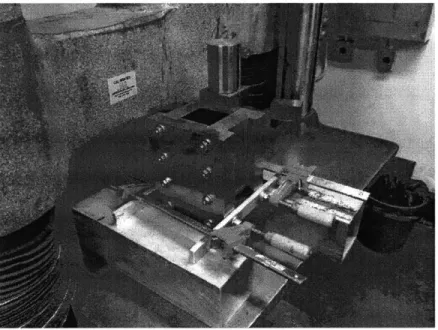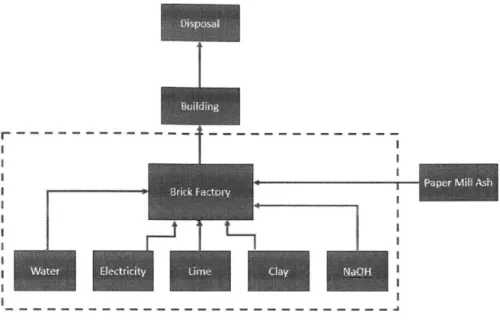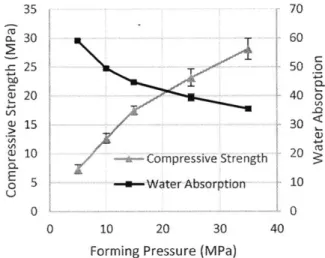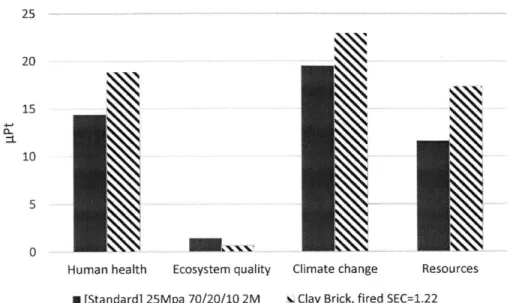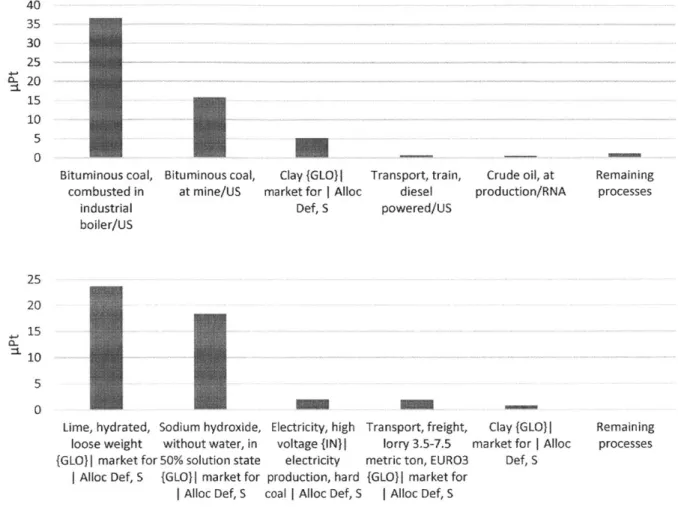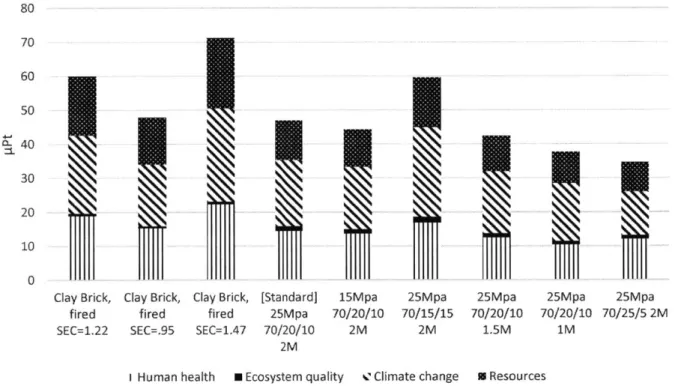Decreasing Water Absorption in and Environmental Analysis
of Alkali Activated Bricks
ARCMES
MASSACHUSETTS INSTITI ITF
By
OF TECHNOLOLOYJUN
0
8
2015
Cecilio Aponte
LIBRARIES
Submitted to the Department of Material Science and Engineering in partial
fulfillment of the requirements for the degree of
Bachelor of Science in Material Science and Engineering
at the
MASSACHUSETTS INSTITUTE OF TECHNOLOGY
June 2015
Massachusetts Institute of Technology 2015. All rights reserved.
Signature redacted
A uthor ...-...-... ... ... Department of Materials Science and Engineering May 1, 2015
Signature redacted
Certified by... ... ...
Elsa Olivetti Thomas Lord Assistant Professor o aterials Science and Engineering Thesis Reader
Signature redacted
Accepted by ... ... ... .
Geoffrey S.D. Beach Class of '58 Associate Professor of Materials Science and Engineering Chairman, Department Undergraduate Committee
Decreasing Water Absorption in and Environmental
Analysis of Alkali Activated Bricks
By
Cecilio Aponte
Submitted to the Department of Material Science and Engineering on May 8, 2015 in partial fulfillment of the requirements for the degree of
Bachelor of Science in Material Science and Engineering
Abstract
Alkali activated bricks offer an alternative to traditional clay fired bricks for use in construction in the developing world. Previous work in this lab focused on creating a robust mix formulation to create these bricks, but they faced high water absorption and were not optimized under pressure molding conditions. The motivation for the work on alkali-activated bricks is based on the claim that they have a lower environmental burden, but this claim has not yet been verified for this formulation. Thus, this thesis focused on the effects of controlled testing of formation pressure and particle size distribution on brick performance and understanding the relative environmental impacts of clay fired bricks and alkali activated bricks. It was found that water absorption and compressive strength have a strong dependence on forming pressure, with 3-day compressive strengths ranging from 7MPa to 27MPa and water absorption from 35% to as high as 60% as forming pressure increased from 5 to 35Mpa. Sieving of the ash used in the bricks to control for particle size distribution had a minimal effect on performance, but the similarity is attributed to the fact that packing density within the selected particle size ranges were similar. Further testing on controlled mixing of particle sizes is needed to see if better performance can be obtained. Life cycle assessment results verify the claim that the bricks perform better from an environmental perspective, but also show the dependence of that performance on variables such as lime content or kiln efficiency.
Thesis Supervisor: Elsa Olivetti
Table of Contents
Abstract ... 2 List of Figures ... 5 Acknowledgem ents... 6 1. Introduction ... 7 2. Literature Review ... 12Alkali Activated (AA ) Bricks ... 12
Pore Structure and Porosity ... 12
Effect on Com pressive Strength and W ater Absorbance ... 13
Durability and W ater Absorption... 13
M ethods of Characterization for W ater Absorption ... 14
Previous research on lowering water absorption... 15
Environm ental Analysis ... 16
3. M aterials and M ethods ... 18
M aterials... 18
Brick M aking... 18
Choice of form ulation... 20
Com pressive Strength Testing ... 20
W ater Absorption Testing ... 21
Life Cycle Assessm ent... 21
Goal and Scope ... 21
Clay Fired Brick M odel... 22
Alkali Activated Brick M odel ... 23
4. Results and Discussion... 24
Form ing Pressure Analysis ... 24
W ater Absorption ... 24
Compressive Strength... 25
Role of Particle Size... 25
Overall Com parison between Standards... 27
Analysis of Process Contribution ... 28
Sensitivity Analysis ... 29
5. Conclusion... 32
List of Figures
Figure 1. Particle size distribution as received of the Texas Rice Husk ash showing the bins of separation for PSD experiments with a bin for particles less than 70 micron diameter, between 70 and 150 micron diameter, and everything above 150 microns ... 18 Figure 2. The experimental brick formation setup with the mold shown in the stage prior to applying formation pressure. The supports and clamps are purely for stabilizing the mold while it is filled, as the bottom plunger cannot support the weight of the mold in... 19 Figure 3. System boundary and life cycle inventory analysis for the production of an alkali activated brick ... 22 Figure 4. The influence of forming pressure on water absorption and compressive strength, showing an inverse relationship with water absorption and a direct relationship with compressive stren gth ... 24 Figure 5. Comparison of water absorption and compressive strength after controlling particle size d istrib ution ... 2 5 Figure 8. LCIA results comparing clay fired bricks to AA bricks using the IMPACT 2002+ methodology, showing the generally lower impact of AA bricks over several categories... 28 Figure 9. Process contribution for the alkali activated brick (bottom) and the clay fired brick (top) showing which processes contributed the most to environmental impact. The units, pPt, are a normalized unit translating damage assessment of different units into one standard for
com parison of relative im pact... 29 Figure 10. Sensitivity analysis of the two brick types across a variety of practical variables, namely kiln efficiency for clay fired bricks and forming pressure and formulation mix for AA b rick s ... 3 0
Acknowledgements
Thank you to Elsa
for your guidance in this thesis endeavor from not having an idea of what to work on until signing the cover page. Without your knowledge, managing and patience, this would have been a
more difficult and less enjoyable experience.
Thank you to Mike and Thomas
for being the greatest master's student and post doc an undergraduate thesis writer could ever ask for. For those hours in the Instron lab, making the mold design, teaching me the fundamental
background, having all of the expertise in the process developed and everything else. This project could not have happened without you.
Thank you to John
for offering your valued advice and input in many different aspects of the project.
Thank you to the Steam thesis crew
for the moral support in the late hours of night, the snacks and the late life ramblings. Together we will graduate.
Thank you to DMSE
1.
Introduction
With a growing global population the need for construction to shelter and support the activities of the earth's inhabitants will increase. This growth is particularly important in developing countries, such as India. India, with a population of 1.25 billion and an annual population increase of 1.41% (The World Bank 2013), will require an estimated 700 to 900 million square meters of commercial and residential space to be built each year until 2030 to match demand. One outgrowth of this significant increase in infrastructure is that the
environmental impact from use of building materials will grow (energy use in operating these buildings will also increase)(Chani, Najamuddin, and Kaushik 2003; Dixit et al. 2010). Clay fired bricks are the current standard, consisting of about 92% of masonry units produced
annually (Maithel et al. 2011), but they are not seen as environmentally friendly due to the high temperature firing process needed to make them and their depletion of clay and coal resources
(Maithel et al. 2011). These problems have led to a push to design building materials with lower impact while offering the same level of quality(United Nations Environmental Programme 2009).
One path in the development has been the use of waste materials as a constituent of building materials, simultaneously decreasing the need for virgin materials and providing a disposal mechanism for the waste (Maini 2010). An example of such a waste is ash. Ash is what is left in boilers after heat production and is a common byproduct of industrial activity (activity which is growing alongside the population). It is a waste that normally is landfilled or otherwise illegally dumped into rivers or other bodies (Roy 2013), which creates an environmental and economic burden. The problem of increased ash production, along with the push to lower environmental
replacing aggregates in cement to bricks made primarily of ash. The bricks examined in this study were produced through a method of curingcalled alkali activation, which uses a basic solution to start a polymerization reaction between the aluminosilicates in the ash.
Previous work has explored the alkali activation of waste materials has been looking at slag material, boiler ash, and fly ash from thermal boilers in industrial settings. Ash from thermal processes is a promising material because it has high concentrations of silica and alumina, needed for the alkali activation process, and its use does not deplete natural resources and goes a step further to aid the problem of waste disposal.
Fly ash comes from what rises into the air from the burning process and is collected by electrostatic scrubbers. Fly ash use in building materials has been more common to favorable composition, small particle size and round particle shape, however small scale industries tend to only have boiler ash, which necessitates their use. Boiler ash is composed of the larger, coarser particles left over after combustion at the bottom of the boiler. Coal burning is the usual source of these ashes, but any burned fuel (e.g. rice husk, organic waste, wood, etc.) will create this waste product but with different properties and composition. A typical problem with boiler ash from mixed fuel sources is a high loss on ignition (LOI), meaning there is more unburned organic material that introduces impurities into the final product.
The alkali activation reaction turns the loose ash particles into a strong, structural material. The general process that occurs involves a dissolution step, where the basic medium causes the alumina silicates in the mix to disassociate and form alumina and silica based monomers
(activation), an aggregating step where these monomers come together and aggregate, and a final precipitation step where the monomers polymerize and precipitate as the amorphous geopolymer
network that provides the mechanical strength. The forming of bonds between aluminum and silicates in an amorphous solid with varying degrees of reaction (Obonyo et al. 2011).
A quick note is needed to mention the difference between alkali activation and
geopolymerization. Alkali activation creates an alkali activated cement material and involves the breaking up of alumina silicates to form networks with free metal ions (alkali) that can lead to leaching, but the products tend to higher strength. Geopolymers continue that reaction with more silica heavy materials (metakaolin, as an example) to form stable, three dimensional, zeolitic structures with no free ions which leads to better durability. The material examined in this study tends to more closely resemble an alkali activated cement material due to the lower
concentrations of activator solution, size of the ash particles, and lower quality of ash compared to metakaolin (in terms of alumina and silica content).
The primary draw to the alkali activation process is that the bricks can be cured at room temperature, and do not require the high firing temperatures of clay fired bricks. From an environmental perspective, this means that both C02 emissions may be reduced and pollutants will be shifted away from the local brick manufacturers. This technology has clear potential to produce an alternative to clay fired bricks, but the beneficial reuse of ash can only occur where ash producers and brick manufacturers work in close proximity. For this reason, work done in this lab has focused on the specific geographical context of Muzaffamagar, India.
Muzaffamagar, an industrial town with around 500,000 inhabitants (Government of India 2011), is known for its sugar, steel and paper industries. The paper mills produce boiler ash in their manufacturing process that they must dispose of and small brick manufacturers rely on clay fired bricks that release emissions into the local air. Since these two industries co-exist in convenient
distance, alkali activated bricks can help lower costs and environmental impacts of both industries (Schuchman 2011).
This work assesses the possibility of improving the environmental performance of masonry units, through low temperature curing of bricks containing byproduct materials. In this way, not only would the energy requirements in brick production reduce, but value could be derived from a currently unused byproduct. To verify this assertion a Life Cycle Analysis (LCA) will be conducted on both the alkali activated bricks and traditional clay fired bricks. This analysis will contribute a quantitative understanding of the relative environmental impact of the two methods, it will identify the processes that impact the environment the most, and it will investigate
whether alkali activation yields environmental benefit (Walker 2013).
Previous work in this research group has developed a brick formulation including lime, clay, ash and NaOH solution that exhibited promising compressive strength, and this formulation was tested in both a field and lab setting. The chosen application for this material in small scale industries in rural India limits both the brick production method and the possible variables to test in the formulation. Namely, the primary production method for industrial scale bricks is using a hydraulic press and the access to certain raw materials, especially lab grade materials or top of the line solutions, is very limited. Though the lab tested bricks proved to have potential for their
strength, they had only been tested by a vibration molding method and had not yet been
optimized for forming pressure, the pressure at which a brick is molded in a hydraulic press. The bricks also still exhibited the problem of high water absorption; the water absorption of the bricks does not adhere to India standards for clay bricks and leaching of ions occurs when water is absorbed, leading to an increased pH of water around the brick. These poor water absorbance properties, which correlate to problems with long term durability, such as strength loss over time,
are a huge barrier to implementation. To address these problems in way that can be implemented in the field, the role of forming pressure and initial particle size distribution (PSD) of the ash on compressive strength and water absorbance will be examined.
Thus this thesis aims to answer the following three questions:
1. What influence does forming pressure have on the compressive strength of alkali-activated, waste-containing bricks?
2. Does forming pressure and controlled particle size distribution reduce the water absorption in alkali-activated, waste containing bricks?
3. How do alkali activated bricks compare to clay fired bricks from an environmental perspective?
2. Literature Review
Alkali Activated (AA) Bricks
The focus of the current study is not on the exact formulation of the alkali activated brick, as that was the result of previous work done in this lab (Laracy 2015). The result of this previous work lead to the use of clay and lime to supplement a primarily boiler ash based brick. This decision was made to account for the potential lower quality of the boiler ash and variability in the ash (which may change with the fuel source that created it). Clay acts as a rich source of alumina and the lime acts as a source of calcium to improve the overall reactivity of the solid source. The following section will discuss porosity as it is developed in the brick and its effect on functional properties.
Pore Structure and Porosity
Pore structure, essentially the size distribution of pores in a material, and porosity, the ratio of bulk material to voids, or empty space, have a large influence on the properties of
cementitious materials. While much of the literature comes from studies of traditional cement materials, the alkali activated materials provide a similar porous internal structure.
There are different types of pores found in such materials that connect and form a pore matrix of interconnected voids. The types of pores include gel pores (0.5-10 nm radius) which are micro pores and have small influence on the strength and water related properties of the brick, capillary pores (5-50OOnm radius) and macro pores that form due to inadequate
pore structure will give insight on how to better process the selected formulation (Kumar and Bhattacharjee 2003).
Effect on Compressive Strength and Water Absorbance
The effects of porosity on compressive strength have been studied in depth in the field of concretes and Portland cement, and it is assumed that porosity in AA bricks would lead to similar changes in performance. Increased porosity leads to a decreased compressive strength in cements (Odler and R6Bler 1985; Zhao et al. 2014; Kumar and Bhattacharjee 2003) and it also increases water absorption through increased space for water to be absorbed due to capillary effects (Nazari and Riahi 2012; Ma, Hu, and Ye 2013; Halamickova et al. 1995).
Theoretical models have identified mathematical porosity-performance relationships (Nazari and Riahi 2012; Schiller 1971; Millington and Quirk 1961) to both try and understand the fundamental mechanism and predict performance.
Durability and Water Absorption
As mentioned earlier, durability problems, such as strength loss due to wet dry cycling, or freeze thaw cycling, are a major barrier to implementation and water absorption and interactions with water are the fundamental cause to many of these problems (Hall 1989). Previous work in my lab identified water absorption as a major barrier to implementation, both as a problem of adhering to Indian building standards for clay bricks, but also because of the potential durability problems associated with water absorption. With the mix design they were using, and molding with vibration, they were reaching water absorption values between 33-42%.
Methods of Characierization for Waler Absorption
Water absorption has been linked to the pore network of the brick and to the absorption of the components of the cement, which, in this case, means the ash particles themselves (Freidin 2007). Although it is known that water interactions lead to durability performance, there are different tests and metrics that measure this interaction. The main choice is between an
unsaturated water flow parameter, hydraulic diffusivity, and a saturated state parameter, water permeability (which is an evaluation of porosity or pore volume).
The standard test for evaluating hydraulic diffusivity involves measuring the sorptivity. The usual test would consist of placing the dried, porous material in a reservoir of water so that the water flows through capillary action in one direction. Sorptivity, S, is defined as
i =st/2 (1)
Where i is the cumulative water absorption per unit area perpendicular to the flow direction and t
is the elapsed time. This property is a single parameter that characterizes the capillary action of water movement and, arguably, is a better indicator of the materials performance in a typical
scenario (Hall 1989).
Water permeability is usually tested by measuring water absorbance (WA), which is simply
wet mass - dry mass (2)
dry mass
The test usually occurs by submerging the porous material in water until a constant weight is achieved, or saturation. The idea is that capillary action will trap water in the pores and thus if more water is absorbed, more pore space is available.
Previous research on lowering water absorption
To address this problem in similar recipes, researchers have attempted a variety of methods that loosely fall into three categories: a) Introduction of water repellent additives to the
formulation b) Changing of processing conditions and c) changing the basic formulation. Water repellent additives such as water repellent fibers (Puertas et al. 2003) or siloxane (Freidin 2007) have been added to formulations in an attempt to lower water absorption by introducing a hydrophobic substance. The idea is that if part of the mix repels water or if the brick is coated in a hydrophobic layer, then water will be kept out of the internal pore structure. Frieden saw a significant reduction in water absorption by using siloxane as both an additive and as a thin coating, however the additive lowered compressive strength significantly and the coating can cause problems with adhesion to mortar.
Changing the processing conditions has come mainly in the form of changing forming pressure and by changing curing conditions such as temperature or humidity. Ahmari and Zhang (2012) saw that with increase in pressure from .5 MPa to 15 MPa, geopolymer bricks went from around 5% water absorption to 2.5%.
There are many ways to change the basic formulation, from changing the liquid/solid (L/S) ratio (the mass ratio of activator solution to dry solids), changing proportions of materials (for example, using less total ash per brick), mixing boiler ash with fly ash (Freidin 2007) or otherwise changing the particle size distribution (PSD), or even using a different activator such as sodium silicate or a different concentration of the same activator (Puertas et al. 2003).
Environmental Analysis
The overall environmental impact of buildings includes the embodied energy from the building materials that go into making the building as well as the energy used by its inhabitants. The latter is typically the more significant component, however, the moderate climate and the scale of building in India is such that brick production is an appreciable burden. Karimpour et al. (2014) found in an international study of residential buildings that around 25% of a buildings life cycle energy use comes from the embodied energy of the building materials. Dixit et al. (2010) found that the greatest potential to reduce embodied energy would come from low energy intensive materials. Therefore, looking at the life cycle of the building material, in this case one brick, can tell us about the potential environmental implications for implementing the
technology. The alkali activated brick does not undergo the energy intensive firing process, but this is balanced by the fact that it also requires NaOH and Lime, which are energy intensive in their upstream production.
It is this prospect of better environmental performance of this technology drives its study in a building material application. However, if alkali activated bricks are to overcome their problem with durability, some of the environmental gains may be lost. For example, higher compaction pressure requires more electrical energy and more material for equivalent volume (Liu, Burkett, and Haynes 2005) and adding a new hydrophobic chemical or higher activator concentration may increase the embodied material impact. In light of the potential for higher environmental burden, and to quantify the specific environmental burdens that the product will create, more analysis will be required.
The typical method to answer such questions is to conduct a life cycle analysis (LCA). An LCA looks at all of the inputs (raw materials, manufactured products, infrastructure) required to
make a product and creates a detailed account of the outputs (emissions to the land, air or water) (Ghattas et al. 2013). By crafting a LCA of a typical clay fired brick and a specific formulation of an alkali activated brick in a regional context, we can compare the environmental impacts on equal footing and look at a larger scope rather than simply looking at only CO2 emissions or
3. Materials and Methods
Materials
The raw materials used in the brick consisted of hydrated lime from Graymont, clay from Stiles and Hart Brick Company, Texas Rice Husk Ash (PSD shown in Figure 1) and NaOH from Fisher Scientific. 4b 100 90 80 70 60 so 40 30 20 10 0 I -Texas R HA 10 100 1000 Diameter (tim)
Figure 1. Particle size distribution as received of the Texas Rice Husk ash showing the bins of separation for PSD experiments with a bin for particles less than 70 micron diameter, between 70 and 150 micron diameter, and everything above 150 microns
Brick Making
The brick consisted of 2M NaOH solution, Texas rice husk ash (RHA), lime and the clay. The NaOH solution was prepared by weighing out 80g of solid NaOH and mixing with IL of water to make a 2M solution. The lime was sifted to ensure the removal of large chunks of lime
that could remain unreacted. The clay was dried in an oven at 1 00*C for three days and
subsequently crushed by either blender or dropping and again sifted to prevent large clumps from entering the mixture. The RHA was used as is, except in the case where it was used to test the effect of the particle size on brick performance. In this case, the ash was sifted by a ROTAP RX-29 sieve shaker to generate three buckets of ash diameter, less than 75 microns, between 75 and
150 microns and over 150 microns.
Figure 2. The experimental brick formation setup with the mold shown in the stage prior to applying formation pressure. The supports and clamps are purely for stabilizing the mold while it is filled, as the bottom plunger cannot support the weight of'the
mold in
Brick production consisted of preparing the dry mixture of ash, lime and clay at the desired ratios by weight and dry mixing in a KitchenAid mixture at low speed for three minutes. Once a homogenous mix was made, the 2M NaOH solution was added to reach the desired liquid to solid ratio (L/S). This mixture is then mixed again, starting at low speed and moving to higher speed as the mix becomes denser and less likely to escape the mixing bowl. This mixing occurs for 10 minutes until the mixture is again homogenous.
The wet mix is then formed into a brick by placing 200g of it into a custom made mold (Figure 2) with a square opening with 51mm sides. Two plungers apply pressure from the top and the bottom of the brick until a predetermined pressure is achieved. The Instron compressed the material at a rate of 4000KPa/min. These bricks are then removed from the mold and wrapped in double layered plastic saran wrap and sealed with duct tape to minimize moisture loss. These samples are placed in an oven at 500C and cured for three days before testing. While the bricks are able to cure at ambient temperature, the higher temperature was used to facilitate the speed of the testing process, as increased temperature enhances the reaction kinetics. Three samples of each formulation are made to ensure repeatability of results.
Choice offormulation
For brick testing, a brick formulation of L/S =.325, 2M activator solution and solid phase weight ratio of Ash/Clay/Lime =70%/15%/15% (which from now on will be identified only by the percentage in the dry mix, e.g. 70/15/15) were used based on previous work done in my lab.
For the LCA, the standard alkali activated brick had a L/S=.325, used a 2M activator solution, and a solid phase weight ratio of 70/20/10. This formulation was chosen to align with a formulation tested in the field by members of my lab.
Compressive Strength Testing
The bricks were tested with a Baldwin Tate-Emery Testing Machine (capacity 60kip) after three days of curing. The samples were removed from their wrapping and were measured to calculate the density and area for pressure measurements. The samples were tested at 250 N/s until failure to determine compressive strength.
Water Absorption Testing
After three days of curing, bricks were placed in an oven at 1
00*C
for 24 hours to drive off water. The bricks were then weighed to obtain the dry mass. The samples were thensubmerged in water for another 24 hours. Lastly, the bricks were weighed again after excess surface water was wiped off. To calculate percent water absorption (WA), we used equation (2).
Life Cycle Assessment
Goal and Scope
The goal of this LCA is to understand the environmental impact of new building materials relative to the existing standard. The claim that this alkali activation technology uses less natural resources and has less global warming potential, but ranges in performance and the variables that effect performance can make this statement unclear and uncertain. Only resources and processes used in manufacturing of the brick will be taken into account, meaning any
processes involved in the actual use of the products or disposal, are assumed to be similar and the particularities are outside the scope of this analysis.
I
Figure 3. System boundarv and lift cycle inventorv analysis for the production ofan alkali activated brick
The functional unit chosen in this study was chosen to be a brick assigned to be 9" long, 4" wide, and 2.5" thick (Walker 2013) for consistent analysis. The analysis was done with the
SimaPro 8 LCA software with data extracted from the Ecoinvent3 library and the chosen method for LCIA was the IMPACT 2002+ method.
Clay Fired Brick Model
Clay bricks are manufactured through five essential steps in the processes: clay extraction and crushing, addition and mixing of water, molding, drying and, finally, firing. Generally, the mixing, molding and drying steps are done manually or otherwise do not consume energy to accomplish so are ignored in this study. This model leaves only clay and water as the resource inputs in the brick and coal for firing. A density of 1.36 g/cm3 for clay fired bricks was used
(Porst, 2015) as an average density of clay fired bricks in Gujarat, India, to determine necessary masses for the functional unit Coal was assumed to be bituminous and the only fuel source for firing. While in the field other fuel sources with different heating values and associated
Alkali Activated Brick Model
The process to produce an AA brick starts with clay extraction, production and shipment of lime and NaOH, grinding and mixing with water and ash, pressing or molding, and then ends with curing. The curing step in this case produces no emissions because it is done at ambient temperatures so it is ignored. Ash use was ignored as it is the waste product of another industrial process, so any environmental costs are allocated to that process, though it is worth noting that implicitly its benefit comes from the reduction of natural clay that is needed in the brick. The molding step requires a hydraulic press, which requires some electricity input. The use phase might also be of importance in environmental impact due to leaching of NA ions (basic leach solution) (Hlavacek 2014), but is ignored in the scope of this study. Information on necessary volumes and masses was extrapolated from experimental results found in the forming pressure study.
4. Results and Discussion
The following section will discuss the results obtained in experimentation and LCA modeling with the aim of answering the questions posed earlier, namely the influence of ash particle size and brick forming pressure on compressive strength and water absorption and the environmental impact of the two brick production methods.
Forming Pressure Analysis
35 70 0- 30 6 25 50 0 CC 20 40 15 30 S10, Cpressive Stiength 20 o 5 -w-WaterAbsorption- 10 U I 0 10 20 30 40
Forming Pressure (MPa)
Figure 4. The influence of forming pressure on water absorption and compressive strength. showing an inverse relationship with water absorption and a direct relationship with compressive strength
Water Absorption
The effect of forming pressure on the water absorption can be seen in Figure 4. The water absorption goes from as high at 59.2% with a forming pressure of 5MPa to around 35.5% at 35MPa. While this result indicates the need for high forming pressures to obtain low water absorption, it is important to note that the water absorption does appear to level off after this pressure, indicating less room for improvement. This happens because the material moves closer to a dense solid and absorption from pores found between the ash particles is minimized. This
can be seen in the stress displacement relationship during the forming process becomes close to vertical at 35MPa. This indicates that there are still pores that cannot be taken away by further compaction.
Compressive Strength
The compressive strength of the brick also increases with an increase in the forming pressure, as expected. If we consider the forming pressure as decreasing the volume of pores, this
leads to a clear increase in the strength.
Role of Particle Size
75-150 m >150 pm
Ash Particle Size
* Water Absorption C Compressive Strength
Standard
Figure 5. Comparison of water absorption and compressive strength after controlling particle size distribution
Water Absorption
The effect of sifting the particles to control for particle size had a minimal impact on water absorption, varying only within 2.7% percent (Figure 5). While the size separated samples,
ii E 0 U4 0 0 eQ 0~ -C C C) (0 50 45 40 35 30 25 20 15 10 5 0 -< 75 pim
received PSD, the difference in performance would not warrant sieving in the field. The particles could be separated into smaller buckets with more extreme sizes to vary the performance more, but this operation would be inefficient given the small fraction of available particles in each bucket. The largest size particles, diameter greater than 150 microns, had the lowest value for water absorption, which was unanticipated. While it was expected that lower particle size would mean a higher surface and a higher degree of reaction, it seems that this effect is either not pronounced enough at the chosen ranges in particle size or the gain is balanced out by some other negative effect, such as increased porosity due to inadequate compression. It is also
important to note that for this sample of ash, the Texas RHA, the composition across particle size is fairly consistent. In boiler ash from paper mills in India, this is not often the case as large particles tend to have a higher LOI, meaning there may be more benefit to separating these larger particles out.
Each sample was compacted to the same pressure which may have led to the unexpected results. Smaller particles may have the capacity to be compacted to higher pressures, but if compacted at the same pressure as a larger particle brick, they may leave more space open for air or water to create pores.
Lastly, the packing of the largest particle size ash may leave the least free space, leading to the lowest density. The PSD of the largest bin naturally contains a more bimodal distribution that would allow particles of smaller size to fit into the gaps between larger particles. To test this further, a controlled batch could me made of ash from the largest and smallest particle diameter bins. It is important to note that fully controlling the PSD with monodispersed sizes is not a feasible task considering the wide range in particle sizes.
Compressive Strength
The performance for compressive strength followed a similar trend considering porosity. If the bricks with the higher particle size had a lower porosity, this explains the higher
performance associated with the increased particle size.
Environmental Impact
Overall Comparison between Standards
Using the IMPACT 2002+ analysis method, the overall impact between the two products could be compared. As seen in Figure 6, the AA brick performed better in the human health, climate change and resource depletion categories and only performed marginally worse in the ecosystem toxicity category. The human health category was mainly dominated by the
production of respiratory inorganics, the climate change category mainly due to releasing of C02 into the atmosphere and the resource depletion category mainly due to depletion of
nonrenewable resources. The small ecosystem toxicity came from production of carcinogens and terrestrial ecotoxicity.
25 20 15 rL 10 5 0
Human health Ecosystem quality Climate change Resources
m [Standard] 25Mpa 70/20/10 2M : Clay Brick, fired SEC=1.22
Figure 6. LCLA results comparing clay fired bricks to AA bricks using the IIPACT 2002+ methodology, showing the generally
lower impact of AA bricks over several categories
Analysis of Process Contribution
As expected, the primary contributor to the clay fired brick's environmental impact came from the use of coal, both from upstream mining and emissions during the brick making process from combustion of that coal. These processes combined contributed 87.5% of the single score metric. For AA bricks, the main drivers of environmental impact were the production of lime, contributing 57.9%, and NaOH, contributing 30%, to the single score metric. These strong dependencies mean that the environmental impact can easily be influenced by even small changes in formulation or processing, indicating the need for a sensitivity analysis around these parameters.
40 35 30 25 CL20 15 10 5 0
Bituminous coal, Bituminous coal, combusted in at mine/US industrial boiler/US 25 20 15 CL 10 5 0
Lime, hydrated, Sodium hydroxide, loose weight without water, in
{GLO} I market for 50% solution state
I Alloc Def, S {GLO}I market for
I Alloc Def, S
Clay {GLO} I market for I Alloc
Def, S
Electricity, high voltage {IN} I
electricity production, hard coal I Alloc Def, S
Transport, train,
diesel powered/US
Transport, freight, lorry 3.5-7.5 metric ton, EURO3
{GLO}I market for I Alloc Def, S
Crude oil, at
production/RNA
Clay {GLOJ I
market for I Alloc Def, S
Figure 7. Process contribution for the alkali activated brick (bottom) and the clay fired brick (top) showing which processes contributed the most to environmental impact. The units, pPt, are a normalized unit translating damage assessment of diferent units into one standard for comparison of relative impact.
Sensitivity Analysis
Table 1. Listing offbrmulations tested in sensitivity analysis
Formulations Forming Ash/Clay/Lime NaOH
Pressure (MPa) I ratio Concentration (M)
Remaining processes
Remaining
processes
The process contribution indicated that coal use in clay fired bricks and NaOH and lime use in AA bricks dominated impact. To translate the sensitivity of these factors into practical, field considerations, the amount of coal used in the firing process was correlated to choice of kiln, or kiln efficiency, as measured by the specific energy consumption (SEC) parameter. This parameter measures the amount of heat that needs to be generated to fire one kilogram of brick; a lower value means the heat is more effectively utilized. To translate the AA brick sensitivity to a real world use, the forming pressure and its effect on material needed to form a brick of the same dimensions as the functional unit (extrapolated from experimental results), the formulation ratios between ash, clay and lime, and the concentration of the activator solution were examined.
Clay Brick, Clay Brick, [Standard] 15Mpa 25Mpa fired fired 25Mpa 70/20/10 70/15/15
SEC=.95 SEC=1.47 70/20/10 2M 2M 2M
I Human health M Ecosystem quality 2 Climate change
I.
25Mpa 25Mpa 25Mpa
70/20/10 70/20/10 70/25/5 2M
1.5M iM
M Resources
Figure 8. Sensitivity analysis of the two brick types across a variety of practical variables, namely kiln efficiency for clay fired
bricks and forming pressure and formulation mix for AA bricks
As seen in Figure 8, the standard AA brick had the lowest single score impact. The most efficient clay fired brick, formed in a vertical shaft brick kiln with an SEC of .95 MJ/kg,
80 70 60 50 40 30 20 10 0 Clay Brick, fired SEC=1.22
performed better than the higher impact AA bricks, but only marginally. This shows that although there may be some cases where a clay fired brick performs better, this only happens in ideal conditions and when compared to the higher end AA bricks.
5.
Conclusion
Forming pressure plays an important role in the availability of pores in an AA material which in turn has a large impact on the compressive strength and water absorption. While increased forming pressure does decrease porosity, the material reaches a limit where the particles are so closely packed that no further improvements can be made from increased pressure. This means that, from a practicality standpoint, other methods will need to be employed to decrease water absorption.
Boiler ash particle size tested in this paper seemed to have a minimal effect on the properties of the brick, indicating that either insufficient and therefore impractical size separation is needed to change the properties or that in the pore forming mechanism in this type of brick is not
dominated by particle size and reaction at the particle boundary.
The environmental impact of the AA bricks tested in this study tend to perform better than the traditional clay fired bricks, but sensitivity analysis shows that this may not be the case if there is efficient kiln technology being used and the formulation uses less ash or a higher activator concentration.
Further work in the testing of water absorption should distinguish between two different aspects of water absorption. First, the durability as is related to water absorption and second, the bonding of bricks to mortar. These two aspects address very practical aspects of water absorption as is related to performance rather than adherence to a standard. In the case of durability, the connection is not entirely clear, so tests and models should be developed to correlate the practical durability with a water absorption metric.
Further work in understanding the environmental impact of this technology should focus on finding a functional unit that can incorporate performance, such as thermal conductivity or compressive strength. While the analysis was clear for a volume based brick sample,
performance changes between cases tested in this analysis, especially amongst AA bricks, were not studied and might show that certain formulations don't show any practical benefit. In addition, modeling the benefit of avoided ash waste being landfilled or otherwise disposed
should be included. Small scale demonstrations of this technology would aid in standardizing necessary performance, size or functionality needed for a brick, would allow a more complete picture as to potential problems, give information on any potential use phase impacts and allow for a more concrete and focused analysis.
With more work done in this space, especially in tandem with practical field work in local regions, such as Muzaffamagar, India, there is a great potential for this technology to lower environmental burden and provide economic benefit to developing industrial and housing markets.
References
Ahmari, Saeed, and Lianyang Zhang. 2012. "Production of Eco-Friendly Bricks from Copper Mine Tailings through Geopolymerization." Construction and Building Materials. doi:10.1016/j.conbuildmat.2011.10.048.
Chani, P.S., Najamuddin, and S.K. Kaushik. 2003. "Comparative Analysis of Embodied Energy Rates for Walling Elements in India." The Institution ofEngineers (India).
Dixit, Manish Kumar, Jose L. Fermindez-Solis, Sarel Lavy, and Charles H. Culp. 2010. "Identification of Parameters for Embodied Energy Measurement: A Literature Review." Energy and Buildings 42 (8): 1238-47. doi:10.1016/j.enbuild.2010.02.016.
Fermindez-Jimenez, A., A. Palomo, and M. Criado. 2005. "Microstructure Development of Alkali-Activated Fly Ash Cement: A Descriptive Model." Cement and Concrete Research
35 (6): 1204-9. doi:10.1016/j.cemconres.2004.08.021.
Freidin, C. 2007. "Cementless Pressed Blocks from Waste Products of Coal-Firing Power Station." Construction and Building Materials. doi: 10.101 6/j.conbuildmat.2005.08.002. Ghattas, Randa, Jeremy Gregory, Elsa Olivetti, and Suzanne Greene. 2013. Life Cycle
Assessment for Residential Buildings: A Literature Review and Gap Analysis. Government of India. 2011. "Population ", 2011 Census of India.
Halamickova, Pavla, Rachel J. Detwiler, Dale P. Bentz, and Edward J. Garboczi. 1995. "Water Permeability and Chloride Ion Diffusion in Portland Cement Mortars: Relationship to Sand Content and Critical Pore Diameter." Cement and Concrete Research 25 (4): 790-802. doi:10.1016/0008-8846(95)00069-0.
Hall, C. 1989. "Water Sorptivity of Mortars and Concretes: A Review." Magazine of Concrete Research 41 (147). Thomas Telford: 51-61. doi:10.1680/macr.1989.41.147.51.
Hlavacek, Petr. 2014. "Engineering Properties of Alkali Activated Composites." Czech Technical University in Prague.
Karimpour, Mahsa, Martin Belusko, Ke Xing, and Frank Bruno. 2014. "Minimising the Life Cycle Energy of Buildings: Review and Analysis." Building and Environment 73 (March): 106-14. doi:10.1016/j.buildenv.2013.11.019.
Kumar, Rakesh, and B Bhattacharjee. 2003. "Porosity, Pore Size Distribution and in Situ
Strength of Concrete." Cement and Concrete Research 33 (1): 155-64. doi:10.1016/S0008-8846(02)00942-0.
Laracy, Michael Edward. 2015. "Valorization of Boiler Ash in Alkali Activated Materials." Massachusetts Institute of Technology.
Liu, Henry, Williams Burkett, and Kirk Haynes. 2005. "Improving Freezing and Thawing Properties of Fly Ash Bricks." In World of Coal Ash. Lexington.
Ma, Y., J. Hu, and G. Ye. 2013. "The Pore Structure and Permeability of Alkali Activated Fly Ash." Fuel 104 (February): 771-80. doi: 10.101 6/j.fuel.2012.05.034.
Maini, S. 2010. Production and Use of Compressed Earth Stabilised Earth Block. Auroville. Maithel, Sameer, Dheeraj Lalchandani, Ashwin Sabapathy, Shwetha A.S., and Vishwa Murthy.
2011. "Strategies for Cleaner Walling Material in India."
Millington, R. J., and J. P. Quirk. 1961. "Permeability of Porous Solids." Transactions of the Faraday Society 57 (January). The Royal Society of Chemistry: 1200.
doi: 10. 1039/tf9615701200.
Nazari, Ali, and Shadi Riahi. 2012. "Experimental Investigations and ANFIS Prediction of Water Absorption of Geopolymers Produced by Waste Ashes." Journal ofNon-Crystalline Solids 358 (1): 40-46. doi:10.1016/j.jnoncrysol.2011.08.022.
Obonyo, Esther, Elie Kamseu, Uphie Melo, and Cristina Leonelli. 2011. "Advancing the Use of Secondary Inputs in Geopolymer Binders for Sustainable Cementitious Composites: A Review." Sustainability 3 (12). Molecular Diversity Preservation International: 410-23. doi: 10.3390/su3020410.
Odler, I., and M. R6Bler. 1985. "Investigations on the Relationship between Porosity, Structure, and Strength of Hydrated Portland Cement Pastes. II. Effect of Pore Structure and of Degree of Hydration." Cement and Concrete Research 15 (3): 401-10.
doi:10.1016/0008-8846(85)90113-9.
Puertas, F, T Amat, A Ferrnndez-Jimenez, and T Vdzquez. 2003. "Mechanical and Durable Behaviour of Alkaline Cement Mortars Reinforced with Polypropylene Fibres." Cement and Concrete Research 33 (12): 2031-36. doi:10.1016/S0008-8846(03)00222-9.
Roy, Ashish. 2013. "Poison Still Flowing into Kanhan Round-the-Clock." Times ofIndia. Schiller, K.K. 1971. "Strength of Porous Materials." Cement and Concrete Research 1 (4):
419-22. doi:10.1016/0008-8846(71)90035-4.
Schuchman, Nina Shayne, and Randolph E Kirchain. 2011. "Environmental and Economic Tradeoffs in Building Materials Production in India." Massachusetts Institute of Technology.
United Nations Environmental Programme. 2009. "Buildings and Climate Change." Sustainable Buildings & Climate Intiative. Ed. Paris: UNEP: Sustainable Buildings and Climate Initiative.
Walker, Miriam E Zachau. 2013. "Modeling Environmental Impact of Unfired Bricks in India." Massachusetts Institute of Technology.
Zhao, Haitao, Qi Xiao, Donghui Huang, and Shiping Zhang. 2014. "Influence of Pore Structure on Compressive Strength of Cement Mortar." TheScientificWorldJournal 2014: 247058. doi:10.1 155/2014/247058.

